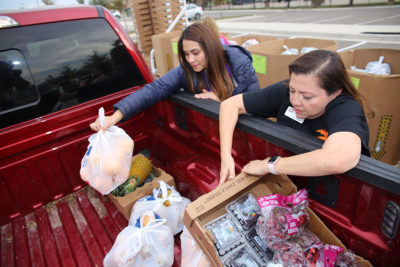A Quarter of Recent Veterans Have Faced Food Insecurity

In late 2018, the VA Texas Valley Coastal Bend Health Care System in McAllen partnered with the food bank of the Rio Grande Valley to fight hunger among veterans and their families by hosting a free produce distribution drive-thru. VA photo
WASHINGTON — Tim, a Navy veteran living in Maine, was injured on the job and found himself unable to return to work. With no income, he applied for benefits through the Supplemental Nutrition Assistance Program. Though unable to work, he was considered an able-bodied adult without dependents, and consequently his SNAP benefits ran out after three months.
Without assistance, Tim became homeless, and found himself going two or three days without food. Even once he found emergency housing, the local food bank’s limited resources meant he was frequently limiting himself to one meal a day. It wasn’t until he turned 50 that the SNAP time limit no longer applied to him and he was able to begin receiving nutrition assistance again.
Tim’s story was presented to the House Veterans Affairs Oversight Subcommittee by Josh Protas, vice-president for public policy for MAZON, a Jewish advocacy organization dedicated to ending hunger, as a not-uncommon example of how financially struggling veterans can be a couple of bad days away from going hungry.
“SNAP is the most crucial tool in helping veterans put food on the table,” Protas told the committee. “Unfortunately, it’s under attack through administrative actions that will increase hunger and hardship for struggling veterans.”
Protas was referring to changes the U.S. Department of Agriculture is planning in how it handles SNAP benefits. States will soon be required to start considering full assets, such as home ownership and retirement accounts, not just income, when determining whether applicants are eligible for SNAP benefits.
In addition, a standard federal rate will be created for how much applicants will be able to deduct from their incomes for utility bills when considering eligibility—a change that will have an outsized impact on states with more extreme weather conditions. And, possibly most importantly, able-bodied adults without children will only be able to receive SNAP for three months without working, volunteering or being enrolled in a job training program.
According to the USDA, these changes will result in approximately 688,000 Americans losing SNAP benefits. How many of those will be veterans or the families of active duty servicemembers is unclear, because the application for benefits does not include a question about military or veteran status.
Food insecurity can have a swift and profound impact on a veterans’ health, explained Thomas O’Toole, MD, senior medical adviser for the Office of the Assistant Deputy Undersecretary for Health for Clinical Operations.
“Not having enough food to eat is too real for many Americans and many of our veterans,” he told legislators. “Its impact is seen in a litany of physical and mental health conditions, preventable ER visits and hospitalizations, and avoidable deaths.”
According to one recent study, 27% of Iraq and Afghanistan war veterans reported food insecurity. Another found that 48% of homeless and formerly homeless veterans lacked regular access to food.
“The consequences are severe and significant,” O’Toole said. “Research has consistently shown a link between lacking regular access to food and poorly controlled hypertension, diabetes, HIV, asthma, depression/anxiety and suicidal ideation. Among older adults, it is associated with reduced activities of daily living and being over two times more likely to report poorer health. Food insecurity is also one of the strong predictors for suicide risk among veterans.”
In early 2016, VA launched the Ensuring Food Security Workgroup, and a screening tool was added to the EHRM to identify veterans in need. Since then, almost 100,000 food insecure veterans have been identified. The first goal has been getting them enrolled in SNAP if they aren’t already.
The screening tool might be too narrow, however, explained Protas. The question currently included in the EHRM reads: “In the past three months, did you ever run out of food and you were not able to access more food or have the money to buy food?”
This question screens for veterans with “very low” food security where their eating patterns and food intake is reduced. However, a larger percentage have “low” food security, which does not reduce the quantity of food, but the quality, variety and desirability of their diets.
“It’s a technical difference,” Protas explained. “But in truth both of these are considered food insecure. People who alter their eating habits have poorer nutrition and poorer health outcomes. The one question that’s currently asked we think just captures very low insecurity. The rate is around 2%. But we know the rate for veterans in general [for food insecurity] is much higher than that.”
Food insecurity also extends to the families of active duty servicemembers. In a survey conducted by the advocacy group Blue Star Families, 7% of military family respondents reported someone in their household facing food insecurity in the past year, and 9% indicated that someone in their household had sought emergency food assistance through a food bank or other charitable organization.
“Things that contribute to food insecurity while still serving are: high rate of military spouse unemployment and under employment; limited availability and high cost of child care; and relocation and housing expenses,” explained Denise Hollywood, programs officer for Blue Star Families. “Many of these factors arise due to frequent relocation due to deployment.”
USDA said it would be willing to partner with VA to compile data on the number of veterans using SNAP but that, without a change to the application process, the exact number of food-insecure veterans receiving benefits will remain unknown.
